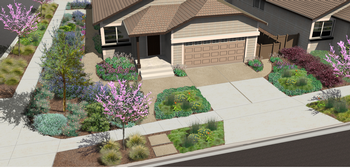Fire-smart Landscaping – it’s a lifestyle – steps you can take towards the new landscape normal
-
Fay Mark
-
Historically, the landscape norm was to use plantings to hide the home’s foundation, have vines and ivy grown on arbors and sides of homes, and trees planted close to the house overhanging the roofs.
Today, living with fire is moving us towards a new landscape norm. With the growing threat of wildfire, we all need to adapt our landscapes to be fire-smart. Plants in your landscape can provide home cooling, enhanced property value, capture and cleaning of water, wildlife habitat, food for your family, and much more. Noncombustible materials contribute to creating pathways, hillside retention, wildlife habitat, water retention, and breaking the continuity of vegetation so that fire cannot spread from plant to plant and reach your home.
Adapting your home can be done step by step as your time and budget allows. With good planning you can pace the necessary changes to create a fire-smart, low-maintenance, climate-resilient, water-efficient, wildlife and earth friendly landscape!
A fire-smart landscape is an upgrade to your home, filled with a blend of well-placed plants and noncombustible materials. The recommended new landscape normal is to minimize or eliminate combustible material within the first five feet of your home.
Steps to transform your landscape to a fire-smart landscape
Step 1: Set goals and priorities. Your overarching goal is to ensure a safe path from your home to your evacuation route for you and your family (egress), and for fire fighters to reach your house (ingress). Contact your local fire agency to learn about the defensible space ordinances that apply to your location. Then document fire-smart landscaping goals and priorities appropriate for the safety of your neighborhood, your property, yourself and your family. Your first goal could be to identify the route from your home to your evacuation route. Another goal could be to evaluate the five-foot perimeter surrounding your house and identify combustible materials closest to your house. Research and understand the nature of the plants that are already surrounding your home. How much dead and combustible material do they generate? How should you address your current landscaping to remove dead debris and combustible material?
Step 2: Develop a plan. Now that you know your goals and priorities, it’s time to assess your current landscape to understand each plant’s purpose, research what type of landscape materials will thrive in the climate where you live and soil on your property, understand your watering requirements, and identify the sunny and shady spots. If working in your garden is a low personal priority, choose low maintenance plants. Trees, shrubs and perennials are excellent choices to begin your research for a low-maintenance landscape. Focus on plants and trees native to California, Australia and Mediterranean summer dry climates. You can find descriptions of low maintenance plants here: http://marinmg.ucanr.edu/PLANTS/EXTRA_EASY/ A rendering of your landscape can help you visualize your planting plan. Photo: City of Santa Rosa and Gates & Associates
A rendering of your landscape can help you visualize your planting plan. Photo: City of Santa Rosa and Gates & AssociatesStep 3: Implement the plan. Implementing your plan can be done by a professional, by yourself, or with friends and neighbors. Slow and steady gets the job done. Commit to making small, incremental and regular changes. Removing dead and combustible materials and making sure your egress and ingress paths are clear is a good place to start.
Step 4: Maintenance. Be proactive rather than reactive. On-going care ensures your plants survive and thrive. Water wisely, fertilize, and monitor for pests, sunlight or lack of it, soil health, and growth to ensure adequate spacing between plants. Keep up the good work!
Adapting your landscape to the new normal of wildland fire will provide a healthy, aesthetically pleasing home for wildlife while creating a defensible barrier from fire for you, your family, your home, and our fire fighters.

